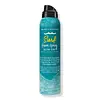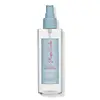What's inside
What's inside
 Key Ingredients
Key Ingredients

 Benefits
Benefits

 Concerns
Concerns

 Ingredients Side-by-side
Ingredients Side-by-side

Water
Skin ConditioningHydrofluorocarbon 152a
Alcohol Denat.
AntimicrobialVp/Va Copolymer
Butylene Glycol
HumectantAcrylates Copolymer
Maris Sal
Skin ConditioningCocos Nucifera Water
MaskingHypnea Musciformis Extract
Skin ProtectingChondrus Crispus
MaskingGelidiella Acerosa Extract
Skin ProtectingMangifera Indica Seed Oil
EmollientCocos Nucifera Oil
MaskingAleurites Moluccanus Seed Oil
Skin ConditioningHydrolyzed Wheat Protein
Skin ConditioningHydrolyzed Soy Protein
HumectantHydrolyzed Wheat Starch
Skin ConditioningEthylhexylglycerin
Skin ConditioningDimethicone PEG-8 Meadowfoamate
EmollientHydrated Silica
AbrasiveButyl Methoxydibenzoylmethane
UV AbsorberEthylhexyl Methoxycinnamate
UV AbsorberEthylhexyl Salicylate
UV AbsorberMagnesium Chloride
Potassium Chloride
Aminomethyl Propanol
BufferingParfum
MaskingHexyl Cinnamal
PerfumingLinalool
PerfumingCitronellol
PerfumingLimonene
PerfumingAlpha-Isomethyl Ionone
PerfumingDisodium EDTA
Phenoxyethanol
PreservativeWater, Hydrofluorocarbon 152a, Alcohol Denat., Vp/Va Copolymer, Butylene Glycol, Acrylates Copolymer, Maris Sal, Cocos Nucifera Water, Hypnea Musciformis Extract, Chondrus Crispus, Gelidiella Acerosa Extract, Mangifera Indica Seed Oil, Cocos Nucifera Oil, Aleurites Moluccanus Seed Oil, Hydrolyzed Wheat Protein, Hydrolyzed Soy Protein, Hydrolyzed Wheat Starch, Ethylhexylglycerin, Dimethicone PEG-8 Meadowfoamate, Hydrated Silica, Butyl Methoxydibenzoylmethane, Ethylhexyl Methoxycinnamate, Ethylhexyl Salicylate, Magnesium Chloride, Potassium Chloride, Aminomethyl Propanol, Parfum, Hexyl Cinnamal, Linalool, Citronellol, Limonene, Alpha-Isomethyl Ionone, Disodium EDTA, Phenoxyethanol
Water
Skin ConditioningSodium Chloride
MaskingPropanediol
SolventGlycerin
HumectantAgave Tequilana Leaf Extract
AstringentOpuntia Ficus-Indica Stem Water
Skin ConditioningPassiflora Edulis Fruit Extract
Skin ConditioningCarica Papaya Fruit Extract
Skin ConditioningAloe Barbadensis Leaf Juice
Skin ConditioningPolyglutamic Acid
Skin ConditioningSalvia Hispanica Seed Extract
EmollientLinum Usitatissimum Seed Extract
PerfumingFurcellaria Lumbricalis Extract
Skin ConditioningPhytic Acid
Citric Acid
BufferingMaltodextrin/Vp Copolymer
Parfum
MaskingSodium Levulinate
Skin ConditioningLactobacillus Ferment
Skin ConditioningPotassium Sorbate
PreservativePhenoxyethanol
PreservativePvp
Emulsion StabilisingBenzyl Alcohol
PerfumingCaprylic Acid
CleansingXylitol
HumectantEthylhexylglycerin
Skin ConditioningSodium Benzoate
MaskingAmyl Cinnamal
PerfumingLimonene
PerfumingWater, Sodium Chloride, Propanediol, Glycerin, Agave Tequilana Leaf Extract, Opuntia Ficus-Indica Stem Water, Passiflora Edulis Fruit Extract, Carica Papaya Fruit Extract, Aloe Barbadensis Leaf Juice, Polyglutamic Acid, Salvia Hispanica Seed Extract, Linum Usitatissimum Seed Extract, Furcellaria Lumbricalis Extract, Phytic Acid, Citric Acid, Maltodextrin/Vp Copolymer, Parfum, Sodium Levulinate, Lactobacillus Ferment, Potassium Sorbate, Phenoxyethanol, Pvp, Benzyl Alcohol, Caprylic Acid, Xylitol, Ethylhexylglycerin, Sodium Benzoate, Amyl Cinnamal, Limonene
Alternatives
Ingredients Explained
These ingredients are found in both products.
Ingredients higher up in an ingredient list are typically present in a larger amount.
Ethylhexylglycerin (we can't pronounce this either) is commonly used as a preservative and skin softener. It is derived from glyceryl.
You might see Ethylhexylglycerin often paired with other preservatives such as phenoxyethanol. Ethylhexylglycerin has been found to increase the effectiveness of these other preservatives.
Limonene is a fragrance that adds scent and taste to a formulation.
It's found in the peel oil of citrus fruits and other plants such as lavender and eucalyptus. The scent of limonene is generally described as "sweet citrus".
Limonene acts as an antioxidant, meaning it helps neutralize free radicals.
When exposed to air, oxidized limonene may sensitize the skin. Because of this, limonene is often avoided by people with sensitive skin.
The term 'fragrance' is not regulated in many countries. In many cases, it is up to the brand to define this term. For instance, many brands choose to label themselves as "fragrance-free" because they are not using synthetic fragrances. However, their products may still contain ingredients such as essential oils that are considered a fragrance.
Learn more about LimoneneParfum is a catch-all term for an ingredient or more that is used to give a scent to products.
Also called "fragrance", this ingredient can be a blend of hundreds of chemicals or plant oils. This means every product with "fragrance" or "parfum" in the ingredients list is a different mixture.
For instance, Habanolide is a proprietary trade name for a specific aroma chemical. When used as a fragrance ingredient in cosmetics, most aroma chemicals fall under the broad labeling category of “FRAGRANCE” or “PARFUM” according to EU and US regulations.
The term 'parfum' or 'fragrance' is not regulated in many countries. In many cases, it is up to the brand to define this term.
For instance, many brands choose to label themselves as "fragrance-free" because they are not using synthetic fragrances. However, their products may still contain ingredients such as essential oils that are considered a fragrance by INCI standards.
One example is Calendula flower extract. Calendula is an essential oil that still imparts a scent or 'fragrance'.
Depending on the blend, the ingredients in the mixture can cause allergies and sensitivities on the skin. Some ingredients that are known EU allergens include linalool and citronellol.
Parfum can also be used to mask or cover an unpleasant scent.
The bottom line is: not all fragrances/parfum/ingredients are created equally. If you are worried about fragrances, we recommend taking a closer look at an ingredient. And of course, we always recommend speaking with a professional.
Learn more about ParfumPhenoxyethanol is a preservative that has germicide, antimicrobial, and aromatic properties. Studies show that phenoxyethanol can prevent microbial growth. By itself, it has a scent that is similar to that of a rose.
It's often used in formulations along with Caprylyl Glycol to preserve the shelf life of products.
Water. It's the most common cosmetic ingredient of all. You'll usually see it at the top of ingredient lists, meaning that it makes up the largest part of the product.
So why is it so popular? Water most often acts as a solvent - this means that it helps dissolve other ingredients into the formulation.
You'll also recognize water as that liquid we all need to stay alive. If you see this, drink a glass of water. Stay hydrated!
Learn more about Water